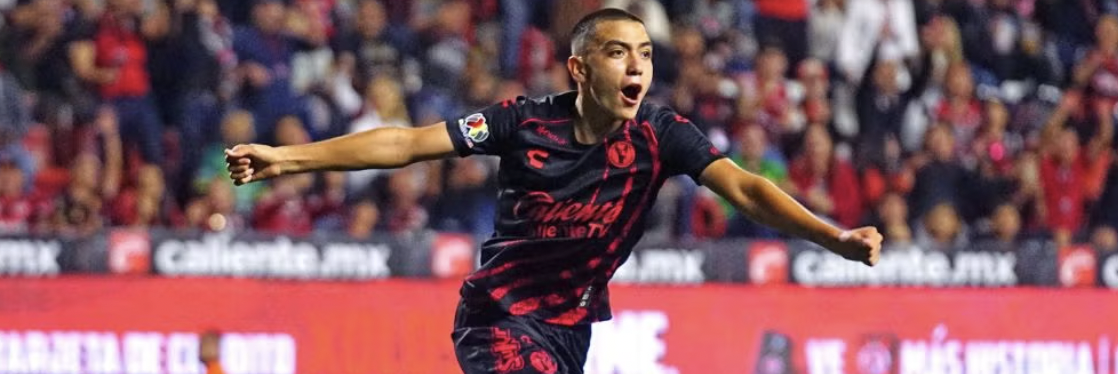- Cambio de Juego (In English)
- Posts
- 10 ways that football clubs should be using analytics
10 ways that football clubs should be using analytics
How teams can create advantages over their opponents
The usage of data and analytics in football is no longer a new concept. Teams like Brentford, Brighton and Liverpool have famously found great success by implementing analytics in their processes, particularly in scouting. Clubs from all across the world have now invested in contracts with data providers and staff for new departments. Also, fans can now access advanced metrics, like xG, on mobile applications (Fotmob, Sofascore) and websites (FBRef, Understat).
In Mexico, CITEC has offered data to Liga MX and Expansión MX teams since 2018, and I’ve worked in analytics since 2019 (mostly in Mexican football); creating, analyzing and presenting metrics and graphics.
However, there are still many teams that haven’t yet invested in data or implemented the processes to get the most out of football analytics (every side in Mexico!). Also, there are cases of clubs that have invested and have developed excellent departments, but aren’t actually using the analytical findings to influence decision making. There are still great opportunities for clubs to generate advantages over their opponents, on and off the field, through the effective implementation of analytics in decision making processes.
There are many ways in which analytics can provide value to a football club, and given some of my past experiences plus ideas I’ve learnt from others, this is my list of 10 key types of analysis that teams should be looking to implement:
Scouting
New contracts
Developing strategies
Pre-match analysis
Collective development
Individual development
Predicting young player potential
Mid-game adjustments
Analyzing training
Analyzing league trends
Scouting
Number one on the list as it’s the most valuable aspect of data analysis in football. Teams spend the majority of their income on players, signings and salaries. Therefore, it’s crucial to take effective decisions. Clubs frequently make errors when signing new players, for example; failing to consider the team play style and individual role, over-estimating experience, or giving too much power to a head coach, who’ll last less time with the team than the player contracts.
Analytics can help. Objective analysis is needed to question opinions, emotions and cognitive biases. With a clear idea of the player required for a specific role on the pitch (the play style and necessary strengths), a team can use analytics to find the most suitable and most productive option.
Parts of an analytical scouting process:
Quickly generate shortlists, without having to watch hours of footage from each individual league.
Analyze player performances in different contexts (league, position, team style).
More details regarding a player’s strengths and weaknesses, with advanced metrics, added context and visualizations of their actions.
Create predictions of a player’s future development and performances, depending on their adaptation to the league and their age.
Analyze every player who emerges from other forms of scouting, to limit errors.
New contracts
Connected to the scouting process is an analysis of new contract decisions, for a potential signing or someone already at the club. Age curves can be under-estimated, and teams can offer lengthy contracts to players that have passed their peak age.
Understanding age curves for different playing concepts and various positions is extremely important. For example, wingers that rely on pace and explosiveness can start to drop-off after reaching 25, but midfielders with great passing ability can maintain their level until 35 or later. Jonathan dos Santos is still a top Liga MX player at 35, but Rodolfo Pizarro produced little in attack last season, at 31.
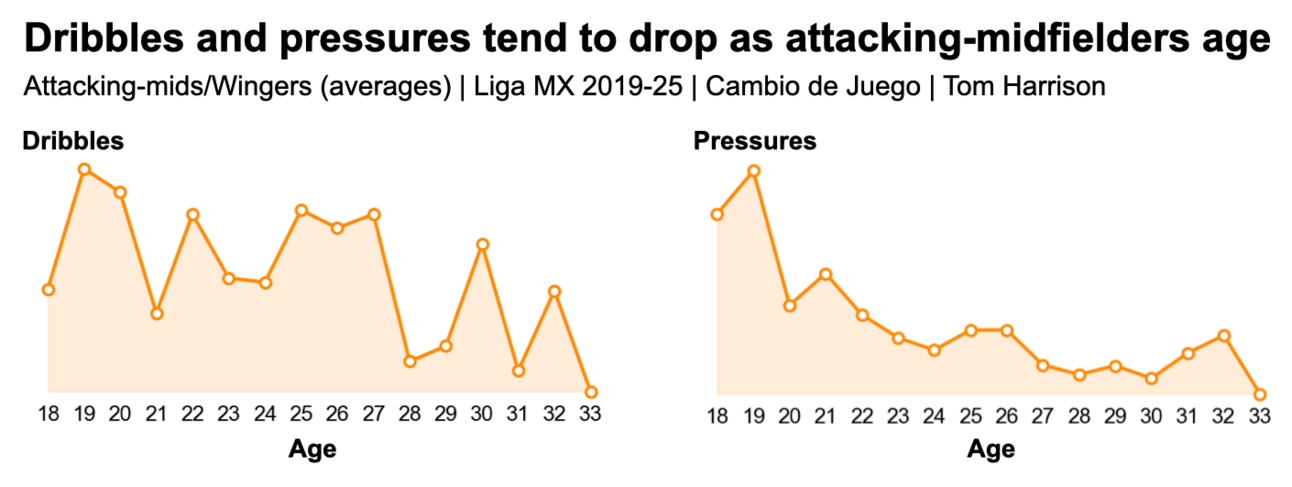
Developing strategies
Whilst there are different ways of playing football, and cases of historic success from various styles of play, there are also key learnings that teams should implement.
For example, teams should base their attacking plans on the creation of shots from inside the box, in central areas. Players must limit the number of shots that they attempt from distance, where there’s a low chance of scoring from, especially when teammates are better positioned.
Crossing zones are also important in football. A historic analysis from Garry Gelade showed that only 2.22% of crosses lead to goals (taking into account direct and indirect, or second phase, goals). However, more than 7% of crosses from a zone inside or very close to the box, create goals. Also, from those zones it’s easier to play a cut-back pass and create a foot-shot, which have higher xG values (goal probability) than a headed shot.
Gelade’s crossing zones. “Zone 4” is much more effective for creating goals.
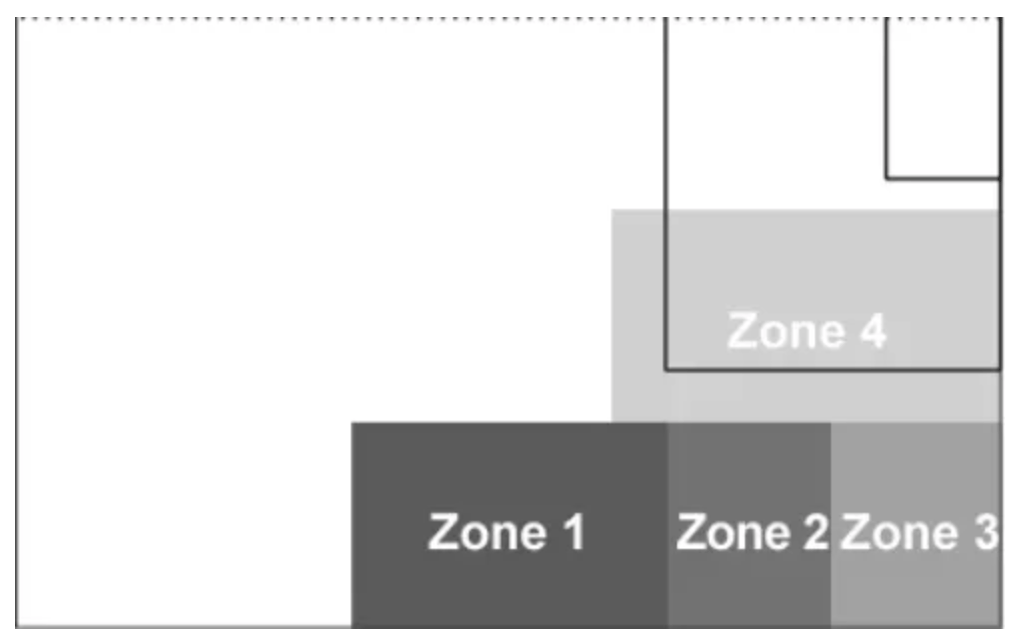
Analysis of crossing in Liga MX during Clausura 2025, and the importance of crossing zones:
Clubs can also base their tactical plans on their transfer policy, or the types of players that their likely to attract. Pachuca is a good example from recent seasons. Los Tuzos played with a high-intensity style under Guillermo Almada, which made sense given their plan to develop young players. Statistical analysis has shown that younger players tend to press more frequently during matches.
More specifically, analytics can be used to decide on specific player roles, depending on their abilities. For example, finding the best corner taker, the most effective player in the air to attack set-pieces, or the more dangerous ball-striker from outside the box, if it isn’t possible to shoot from inside the area.
Finally, analytics have suggested that a greater focus on set-pieces, and attempting more long-throws into the box, could improve a team’s goal production.
Pre-match analysis
An analytical report can speed-up the video analysis process, and back-up concepts shown in the video report.
Analyzing how different teams rank in a variety of metrics can create an idea of the play style, strengths and weaknesses. Visualizations made with event data helps to better understand how teams attack (more centrally or out wide, or if they have a stronger flank), where they press more, passing combinations in build-up, progression routes, and their weakest zones. New “tracking” data, showing the positioning of every player in every game moment, opens many more possibilities in the tactical analysis process.
Also, it’s important to focus on the individual; preparing players for their direct duel, planning set-piece responsibilities, and analyzing penalty trends.
I believe it’s effective to present the statistical analysis alongside the video report, as well as creating digital/physical copies. It’s vital to maintain balance in the reports, without too much team praise or criticism, and to learn how a head coach best interprets the analysis (which types of visualizations).
For example, a heat map displaying a selection of Club América events, showing their trend to build and attack more on the left, cross and shoot more from inside the box, and win back fewer balls in the opposition half.
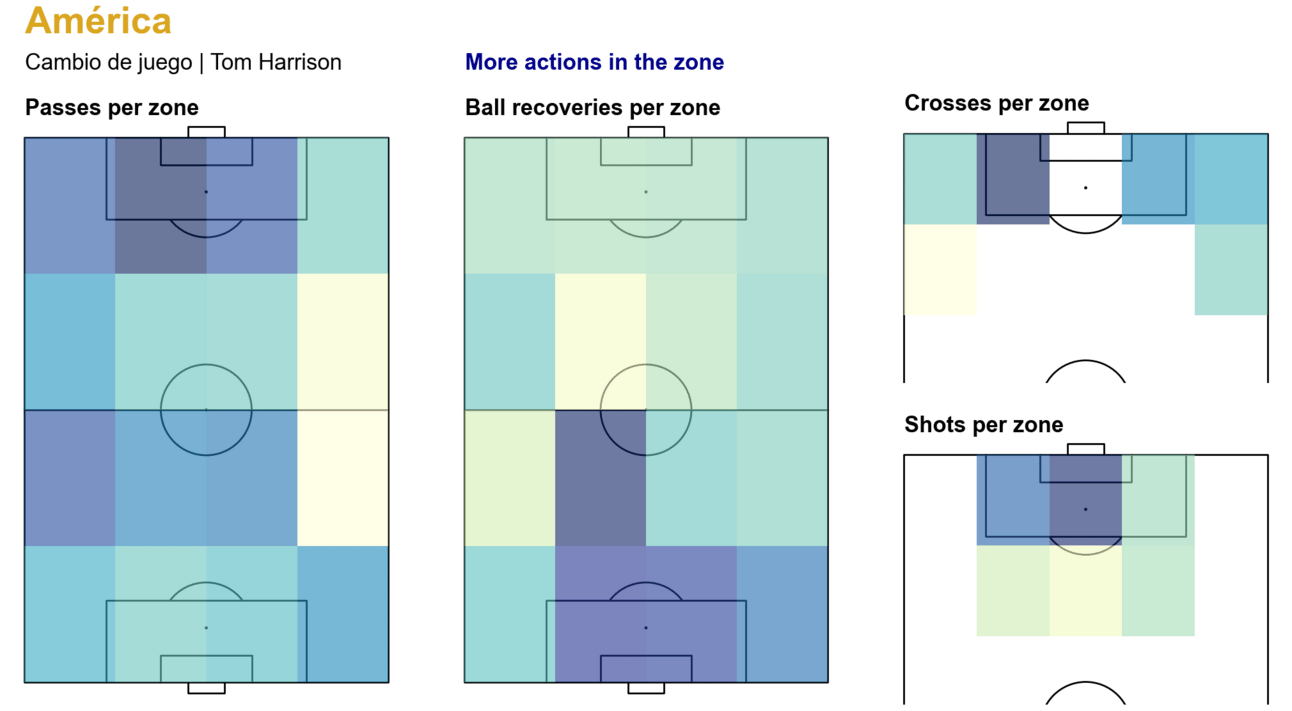
And an individual analysis of Tigres’ midfielders. It’s important to block passing lanes towards the right side when Juan Brunetta has possession, due to his preference to pass to the right.
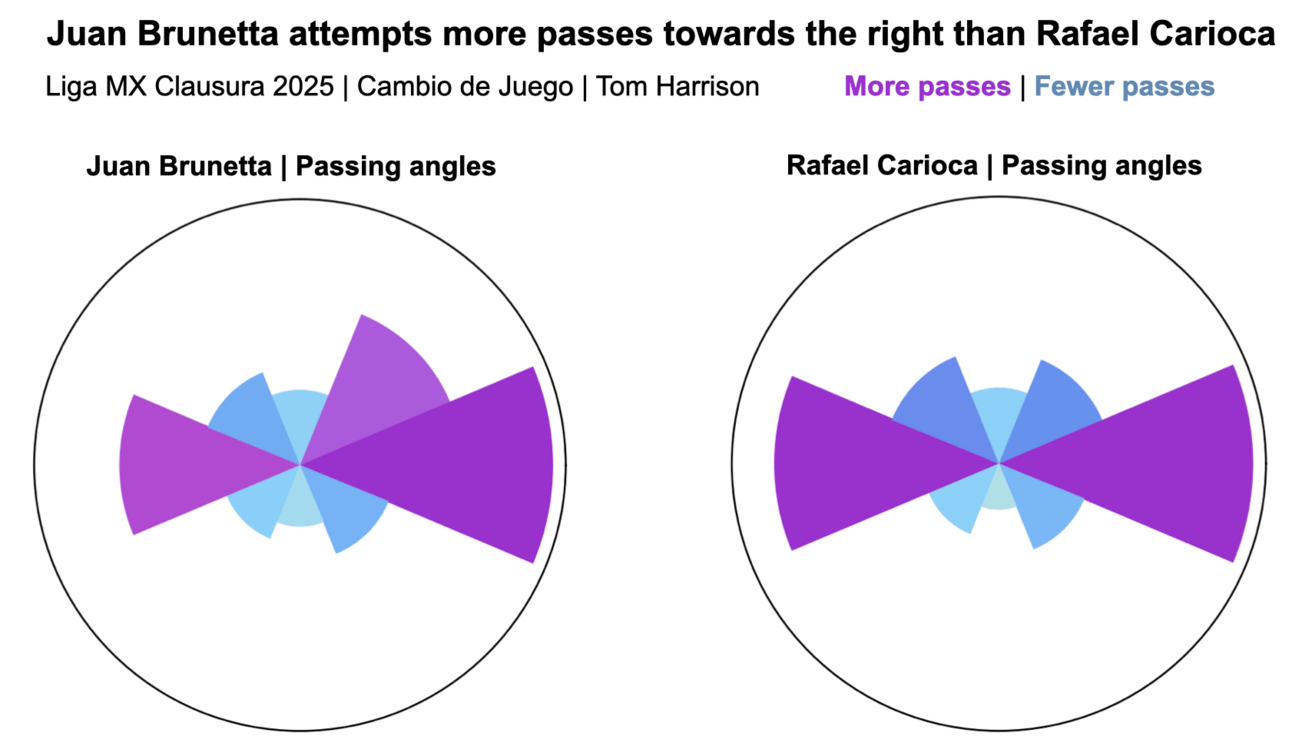
Collective development
Rather similar to the process of analyzing the next opponent. Once again using metrics and visualizations to understand, objectively, the team’s play style, strengths and weaknesses. A report every 6 to 8 games creates enough of a sample size to have reliable results, but also time to influence training sessions and the season overall.
A moving average is a great method of visualizing the changes in a team, whilst taking into account a good sample size of matches.
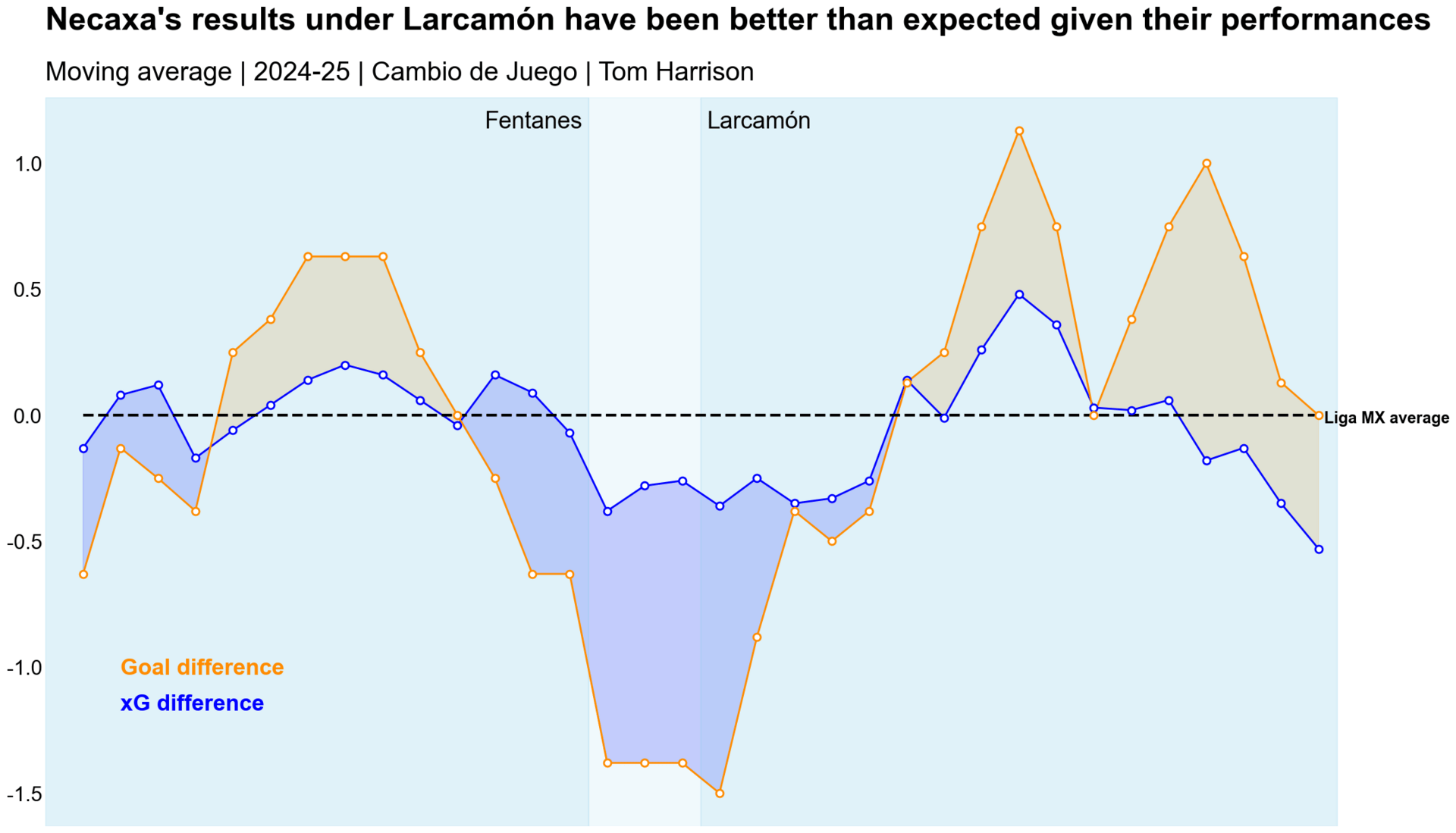
To support collective development, show impactful information and maintain trustful relationships, it’s crucial to have a clear idea of the desired play style, and how to measure it. For example, it isn’t relevant to show the lack of short goal kicks in a presentation if the game model is to hit more long balls from restarts. However, analyzing aerial duels won and second balls would be valuable information.
Individual development
Every player at a club should have an individualized development plan, in the context of their role within the team’s style, that shouldn’t change just because a new head coach has arrived.
Analytics are part of this process; identifying concepts to improve, following player development and analyzing in greater detail. Does a holding-midfielder lose the ball more frequently when they receive a pass from the left or the right side? Is a goal-keeper more susceptible at their near or far-post? Does a winger make effective decisions after dribbling past an opponent? We can provide answers to all of these questions, and many more, with analytics.
Afterwards, I would connect the findings to the video, in order to discover more trends, understand the “why” behind the trends, and create a development plan.
A simple example of such analysis comes from my article about Luka Romero’s blocked shots:
Predict young player potential
This can be challenging, or even impossible, depending on the availability of academy-level data. In Liga MX, we’ve had coverage, from Golstats, of three different youth categories since 2018 (the Sub-17, Sub-19, and Sub-23 leagues as of now).
Golstats metrics are rather basic, however, I’ve been able to produce a historical analysis, per position and role, and generate percentage probabilities that a youth player will make it in the first team. This information can help teams to make better decisions regarding their young players, their contracts and development plans. Too many decisions are only based on the opinions of sporting directors and head coaches.
Mid-game adjustments
Once again data availability, and quality, may be a limiting factor here, but live data could be useful to aid decision making, providing objective information during moments of high stress and emotion.
Physical metrics can help coaches to plan and make substitutions, in order to limit injury risk. Tactical visualizations can show if a team is struggling down a certain wing, or if a player is consistently creating dangerous opportunities, or finding space to receive the ball.
Analyzing training
Manually, or with new technology, it’s possible to collect metrics from training and maintain a catalogue of session types and concepts worked on.
Professional teams have already been using physical data from training for many years, supporting the work of fitness coaches and helping to reduce injury risk. However, with technical/tactical metrics, it’s possible to develop a better understanding of the level of young players and of those that aren’t getting regular minutes. A team can also analyze some specific concepts that don’t occur too often during matches (shots, penalties, free kicks).
Moreover, by registering types of training sessions and the concepts focused on, teams can use objective information to analyze the work of a coaching staff, and better understand the connection between training and matches.
Analyzing league trends
Finally, with data, it’s possible to analyze play style trends across a whole league. Did you know that more Liga MX team play short from the back now? Or that high pressing dropped across the league when fans weren’t allowed into stadiums during covid?
Also, we can visualize how styles and specific action zones vary during a specific tournament.
For example, analyzing crossing zones in Clausura 2025, and the player who most frequently crossed, per team.
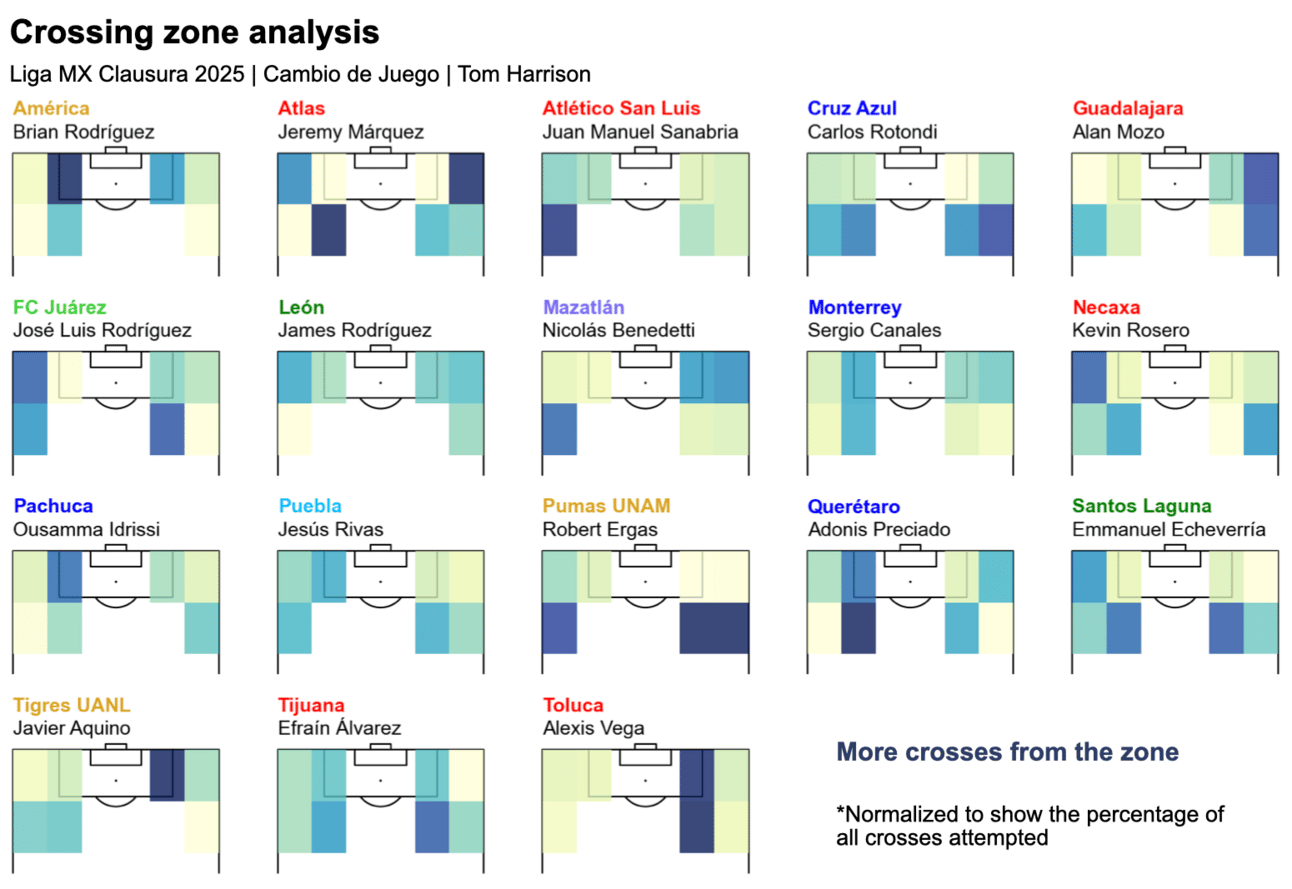
Analyzing trends across a league, players, and football in general can help to adjust a team’s philosophy and maintain long-term preparation. Also, a club with a lower budget can decide to make decisions that go against the trends, or at least against trends of wealthier sides. This can lead to advantages on and off the pitch, for example, facing teams that aren’t as prepared for your style of play, and less competition for the types of players required for your philosophy.
There’s a huge variety of metrics and data providers available for clubs right now, which could offer huge value, if teams have the right people involved and the mentality to adapt and exploit new forms of analysis. However, there are teams stick to the same processes, continue to commit the same errors, and are slow to adapt. With more openness to new ideas, clubs can gain advantages over their opposition, on and off the pitch.
Thank you for reading, if you’d like to contact me regarding any questions, comments or to consult my services, you can contact me on:
Linkedin - https://www.linkedin.com/in/thomas-harrison-a682a2175/
Twitter/X - https://x.com/tomh_36
También, se puede leer este artículo en Español- https://cambiodejuego.beehiiv.com/




